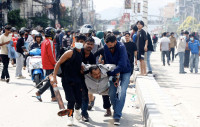National
No man’s land
That our state cares for no one, Madhesis and Pahadis alike, lies in its response to the April Earthquake
Deepak Thapa
For numerologists, the number ‘222’ may have some significance, good, evil or whatever. For non-believers like us, however, if that is the number of days one has to live in temporary accommodation in the hope of government help that shows no sign of materialising, it is quite a few days too many. For, exactly that long a time has elapsed today since April 25, when the lives of millions of people were upended by the Great Earthquake.
After having been caught flat-footed in its response to the quake, the government did redeem itself somewhat by bringing together donors two months later to secure pledges worth $ 4.4 billion. But since then it has been all downhill. The immediate assistance of Rs 15,000 took a while in reaching the affected. That was understandable considering the need for on-the-spot verification of damages, collecting the particulars of the affected, disbursement of budget, and actual distribution. What is not understandable is why it should have taken the government so long to start providing the promised assistance. Imagine living in a state of limbo, not being able to begin life anew, waiting for a seemingly uncaring government to get its act together.
Just as a reminder about the extent of loss, and this is from the Department of Urban Development and Building Construction (DUDBC), “600,000 private homes were fully damaged [and]... more than 285,000 private homes were partially damaged.” That is nearly a million families who have been leading an existence that is going to be even more precarious with the onset of winter. It is a shame that any government should allow this state of affairs
to continue for so long, and even more shameful is no attempt to rectify the situation even now.
Big talk
At the June donor conference, there was some smooth talking from the Finance Minister at the time to get the donors to open up their wallets. First, acknowledging that “a joint concern of both the government and our development partners in recent years has been the quality and pattern of public expenditures,” Ram Sharan Mahat said, “Not to let the same bureaucratic and political hurdles slow the urgent task of rebuilding, the government has boldly announced the creation of the National Reconstruction Authority (NRA). It is an Extra-Ordinary Mechanism (EOM) that is informed by international practices and is grounded on past Nepali successes.”
At the same donor conference, then Prime Minister Sushil Koirala, had asserted: “We are committed to ensure that transparency remains at the core of the reconstruction effort.” Notwithstanding the unmentioned ‘past Nepali successes’ as well as later assertions by Mahat that the government would appoint someone apolitical to head the NRA, his party, the Nepali Congress, and its coalition partner CPN-UML soon got embroiled in a tug-of-war about who should lead it. That all but exposed the lie to the stated commitment to transparency and to not politicising an issue that should have been guided solely by a moral imperative. The papers are full of reports on how the continuing tussle between the two main parties has prevented the NRA Act from being passed but the party leaders appear not to care two hoots about what this does to their standing, and to the endless suffering of the people.
Months later, we are still without the NRA, the body meant to mobilise the funds the donors are ready to give and provide succour to the earthquake-affected. The government’s recently released white paper on the economy detailed the cost of this inaction. Of the promised aid for reconstruction, the first quarter of the current fiscal year had seen receipts of only 11 percent of the grant amount and just 5 percent of the loans. Thankfully, even that was received, enabling the government to plan on distributing the Rs 10,000 handout to each affected family ‘to buy warm clothes’ and tide them over the cold season.
There is little indication of when the Rs 200,000 meant for the reconstruction of houses is going to come through. Neither does there seem to have been any consideration of how inequitable the provision of a flat sum to everyone can be. Hence, a family living next to a motorable can have the construction material trucked right up to the doorstep while another not so fortunate will have to have everything carried on human back up to their home, and perhaps expend a good chunk of the government aid in transportation alone. Anyone with any knowledge of the settlement patterns in the hills and mountains of Nepal will know how this can further exacerbate existing inequities in terms of both caste/ethnicity and class.
Bureaucratic hoops
The truth of what lies in store for the thousands waiting for government assistance when it comes through is even more distressing. As Kathryn March, a professor at Cornell University in New York, wrote about what she found as she did the rounds of various government offices trying to implement her small ‘project’ of training construction workers in the Nuwakot locale where she has been conducting research for decades. It goes as follows (with some paraphrasing by me): i) homeowners must demonstrate that they are eligible for subsidies and/or loans by, first, obtaining an Earthquake Victim ID Card (at least one trip to the relevant district office) and, second, the interrelated opening of a bank account (another trip); ii) then they must select one of the approved house
designs from the DUDBC catalogue; iii) first, 25 percent will be advanced to allow them to build the foundation, according to the DUDBC Building Code standards; iv) after the foundation is finished, homeowners are supposed to call in an engineer to approve the quality of the work, and there is supposed to be an engineer deputed to every VDC with over 1,000 households (and a sub-engineer to those with less)—that is a lot of engineers to be convinced to go work in the villages; v) when the foundation is approved, another 35 percent is to be released for the construction of the walls; vi) then another check by the engineer and another 30 percent for the roof; and vii) another check and the final 10 percent released upon the code-certified completion of the entire structure. Enough to make anyone’s head spin.
The DUDBC catalogue itself appears to be a fine piece of document. So far published only in English (but hopefully soon in Nepali as well), the engineers have, unfortunately, come up with something that only people well-versed in technicalities will comprehend. While explaining its content in lay terms is going to be a challenge, it is very unlikely that the Rs 200,000 will go far while adhering fully to the DUDBC manual. Even more, one can only imagine what the actual ‘cost’ will be to the homeowner with all those inspections mandated for every tranche to be released.
The Tarai is on fire because Madhesis feel neglected by the centre. Although the comparison may not be wholly accurate, our state has been no less uncaring of the Pahadi population, and proof of that has been in its response to the April Earthquake.




 11.12°C Kathmandu
11.12°C Kathmandu















